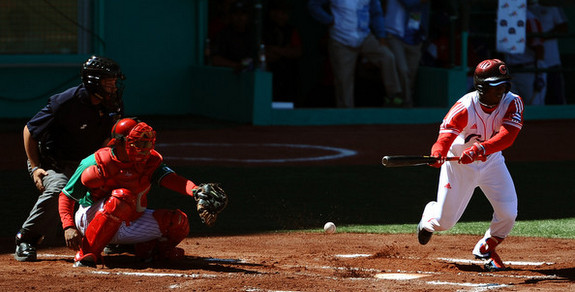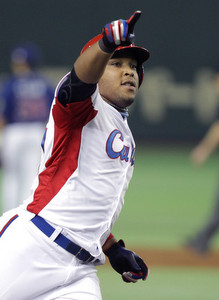
Late last week, the Red Sox signed free agent Cuban outfielder Rusney Castillo to a seven-year contract worth $72.5M. He’ll play in some minor league games this week and make his MLB debut in September. The Yankees were connected to Castillo — they reportedly liked him more as a second baseman — but opted to “end any pursuit” of him a few days before he wound up in Boston. Here are some notes on the international market, including some more details on New York’s pursuit of Castillo.
Yankees never made offer to Castillo
Both Jon Heyman and Joel Sherman report the Yankees did like Castillo — they saw him as a potential 20-homer player — but balked for luxury tax reasons once the bidding got up to $40M. They didn’t even make a contract offer. The Yankees are taxed 50% on every dollar they spend over the $189M threshold, so $72.5M for Castillo would have meant a $108.75M total investment, and they didn’t view him as that type of player. They considered him to be similar to trade deadline pickup Martin Prado. One thing is clear: the price for Cuban free agents is only going up with each new player who arrives.
The Next Big Thing
Isn’t it amazing how as soon as one high-profile Cuban player signs, the next one pops up? Ben Badler puts on a name on that next big thing, and it is 19-year-old Yoan Moncada. He is described as a “a 6-foot, 210-pound switch-hitting infielder who’s the best teenager to leave Cuba since Jorge Soler, a player with exciting tools and dominance of the Cuban junior leagues on par with what Yasiel Puig did at the same age.” Here’s the obligatory video The video was removed from YouTube for whatever reason.
Now here’s the catch: no one seems to know where Moncada is at the moment. Badler says it doesn’t appear he is in Cuba but other reports say he is still on the island. If he is still in Cuba, it will obviously be a long time before Moncada is able to sign with a big league team, if ever. If he has defected, teams still have to wait for MLB to declare him a free agent and for the Office of the Foreign Assets Control to unblock him.
Because he is only 19, Moncada will be subject to the international spending restrictions clubs deal with each summer. The Yankees are unable to sign a player for more than $300,000 during the 2015-16 and 2016-17 signing periods as a result of this year’s international spending spree, so they won’t be able to make a serious play for Moncada if he becomes the available anytime soon. That’s the risk with going big in one signing period, taking yourself out of the running for the top talent in future years.
Tomas establishes residency

Cuban outfielder Yasmani Tomas has established residency in Haiti, according to Jesse Sanchez. That is a big and necessary step towards being unblocked by the OFAC and declared a free agent by MLB. It’s still likely he will not be able to sign with teams until the offseason, if not sometime in 2015. Because of his age (23) and service time in Cuba, Tomas will not be held to the international spending restrictions.
Back in June, Badler described Tomas as a “righthanded-hitting corner outfielder” who can “hit towering home runs thanks to the strength from his thickly-built 6-foot-1, 230-pound frame,” though he cautioned Tomas has “some swing-and-miss tendencies” and an “uppercut stroke and trouble handling good breaking pitches.” Tomas is also described as a below-average runner who will be a corner outfielder in the big leagues. Here’s video. Jim Salisbury says the Phillies intend to be major players, for what it’s worth.
MLB implements new rules to curb pre-July 2nd deals
Last week, MLB sent teams a memo detailing new rules for how they are allowed to evaluate international amateurs, according to Badler. Players are now no longer allowed to be at a team facility until they are 16 years old or until six months before they are eligible to sign, whatever comes first. Before that, players can go to team facilities for MLB sanctioned league games and showcases only. The rule change is effective immediately.
Under the old rules, teams would bring players to their complex and have them work out. If they liked what they saw, they would make an offer and often agree to a contract in advance of the signing deadline. Teams would “hide” players they like at their complex so other clubs couldn’t scout them. That isn’t possible anymore. Long story short, MLB is trying to crack down on pre-July 2nd deals, and limiting how long players can spend at team complex is a big step towards doing that.
Leave a Reply
You must be logged in to post a comment.